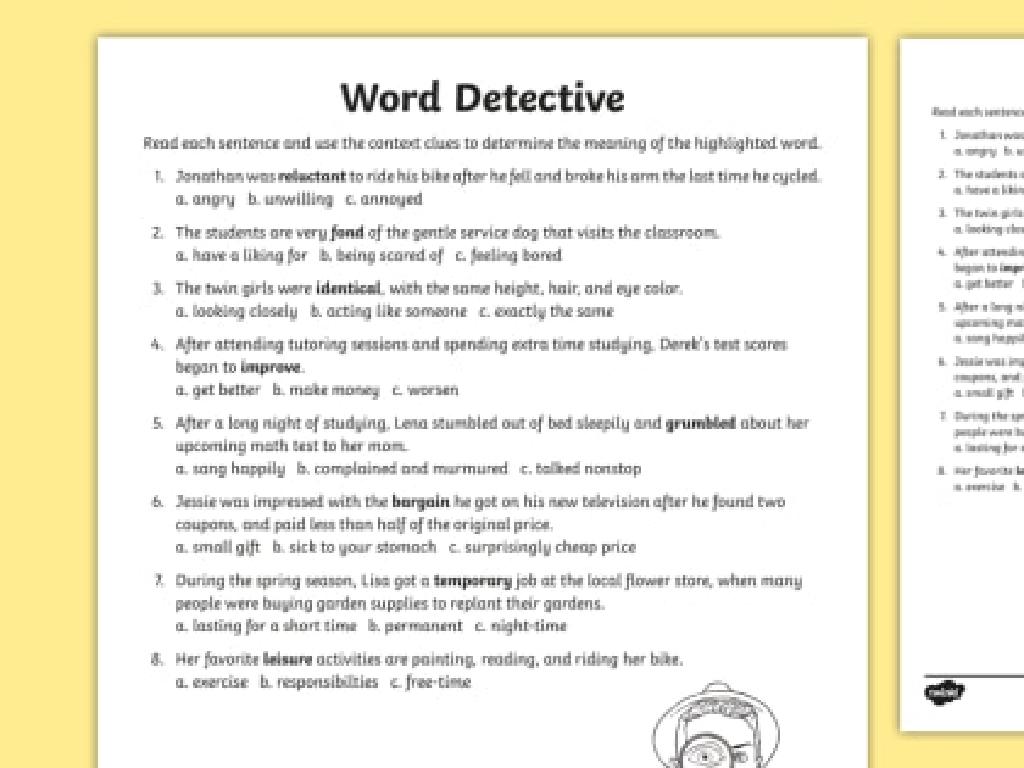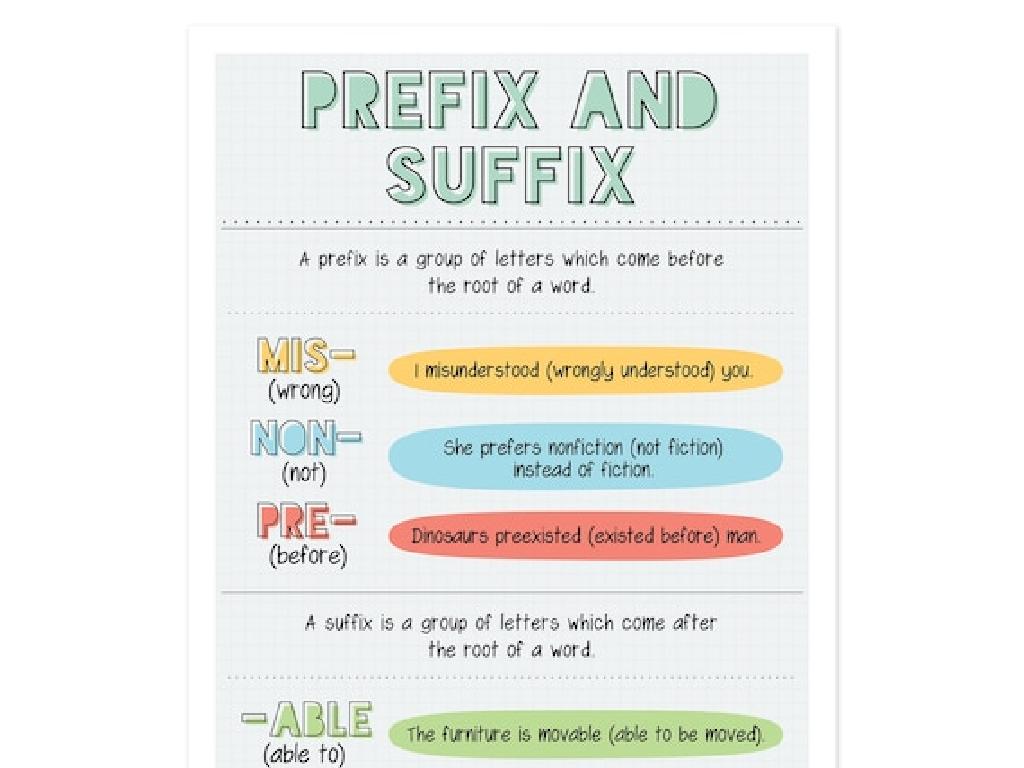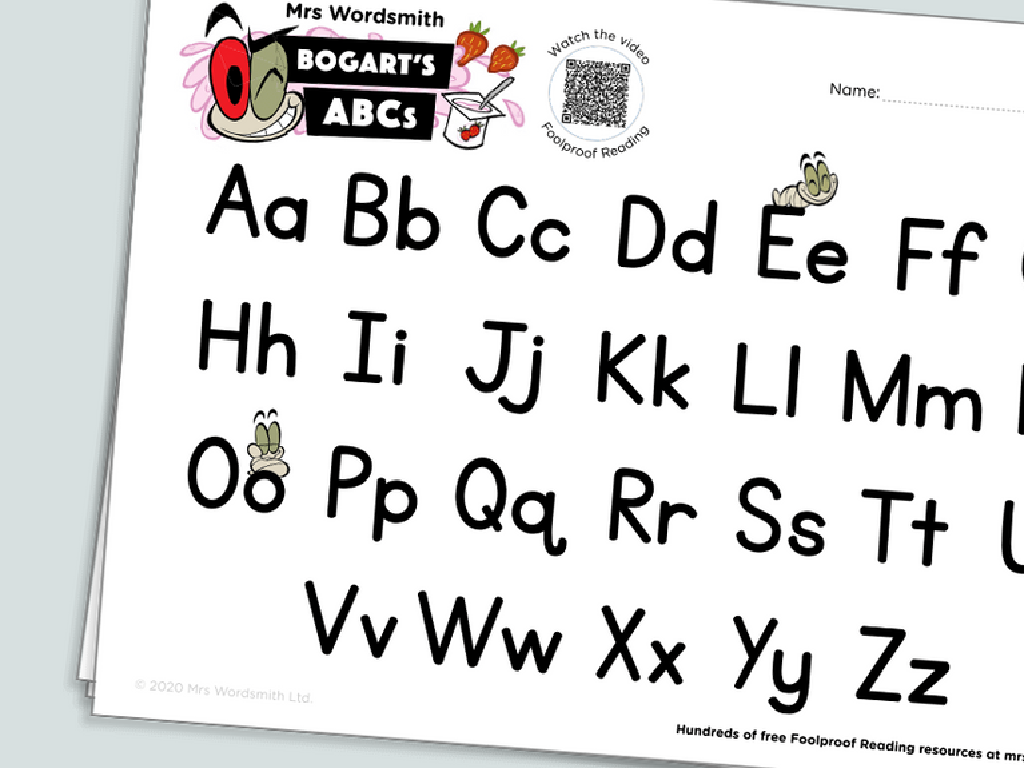Divide 2-Digit And 3-Digit Numbers By 2-Digit Numbers: Word Problems
Subject: Math
Grade: Fifth grade
Topic: Division
Please LOG IN to download the presentation. Access is available to registered users only.
View More Content
Introduction to Division
– Recap basic division concepts
– Review division facts and methods
– Division as equal parts
– Imagine dividing a pizza into equal slices
– Division’s role in daily life
– Use in budgeting, sharing, and more
– Engaging division word problems
– Solve problems related to real-life scenarios
|
Begin the lesson by reviewing the basic concepts of division to ensure a solid foundation for all students. Explain division as the process of splitting a whole into equal parts, using tangible examples such as dividing a pizza among friends to illustrate the concept. Emphasize the importance of division in everyday life, such as dividing up chores, sharing snacks, or budgeting weekly allowances. Introduce word problems that apply division to real-world situations, which will help students understand the practical applications of division and enhance their problem-solving skills. Encourage students to think of their own examples of how they use division in their daily lives.
Division Vocabulary: Key Terms
– Define: Dividend
– The number being divided, e.g., in 84 ÷ 12, 84 is the dividend.
– Define: Divisor
– The number by which we divide, e.g., in 84 ÷ 12, 12 is the divisor.
– Define: Quotient
– The result of division, e.g., in 84 ÷ 12, 7 is the quotient.
– Define: Remainder
– What is left over after division, e.g., in 85 ÷ 12, remainder is 1.
|
This slide introduces the fundamental vocabulary of division, which is essential for solving word problems involving division of 2-digit and 3-digit numbers by 2-digit numbers. The dividend is the number that is being divided up. The divisor is the number that the dividend is being divided by. The quotient is the result of the division, and the remainder is what is left over if the dividend cannot be evenly divided by the divisor. Provide examples for each term to solidify understanding. Encourage students to identify these terms in practice problems and to use them when describing the steps they take to solve division word problems.
Dividing by 2-Digit Numbers
– Steps for 2-digit division
– Divide, multiply, subtract, bring down, and repeat
– Example: 84 ÷ 12
– How many groups of 12 in 84? 84 ÷ 12 = 7
– Place value in division
– Knowing place value helps in arranging and solving
– Practice with word problems
|
This slide introduces students to the concept of dividing by 2-digit numbers. Start by explaining the steps involved in the division process: divide, multiply, subtract, bring down the next digit, and repeat until completion. Use the example 84 ÷ 12 to illustrate these steps in a clear and practical way. Emphasize the importance of understanding place value as it helps students to correctly arrange numbers and understand the size of numbers during division. After explaining the concept, provide word problems for students to apply what they’ve learned. This will help solidify their understanding and give them practical skills in solving division problems involving 2-digit divisors.
Dividing by 3-Digit Numbers
– Steps for 3-digit division
– Divide, multiply, subtract, bring down, and repeat
– Example: 156 ÷ 13
– How many times does 13 go into 156?
– Common division mistakes
– Forgetting to bring down the next digit
– Practice problem-solving
– Try 245 ÷ 15 on your own
|
This slide introduces students to the process of dividing by 3-digit numbers. Start by explaining the steps: divide the highest place value digit by the divisor, multiply the result by the divisor, subtract from the dividend, bring down the next digit, and repeat the process. Use 156 ÷ 13 as an example to demonstrate these steps. Highlight common mistakes such as forgetting to bring down digits or incorrect multiplication and subtraction. Encourage students to practice with additional problems like 245 ÷ 15 to reinforce their understanding. Provide guidance on checking their work for accuracy.
Understanding Division in Word Problems
– What are word problems?
Word problems describe math situations using words.
– Finding division in problems
Look for phrases that imply comparison or sharing equally.
– Key words for division
Words like ‘per’, ‘each’, or ‘split’ often signal division.
– Practice with examples
Let’s solve a sample problem together in class.
|
This slide introduces students to the concept of word problems and their significance in applying math to real-world situations. Emphasize that word problems help develop critical thinking by requiring students to extract and apply mathematical operations from textual descriptions. Teach students to identify key phrases that suggest division, such as ‘divided by’, ‘per’, ‘each’, or ‘split into equal parts’. Provide examples and encourage students to underline or highlight these clues in word problems. Conclude with a class activity where students work through a sample problem to apply these concepts. This will prepare them for more complex problems where they’ll need to discern the correct operation to use.
Solving Division Word Problems
– Carefully read the problem
– Find numbers and their meaning
– E.g., ‘120 apples’ and ‘boxes of 15’
– Write the division equation
– Use the numbers to form an equation
– Solve the problem step by step
– Follow the division steps to find the answer
|
This slide is aimed at guiding students through the process of solving division word problems. Start by reading the problem thoroughly to understand the scenario. Next, identify the key numbers and what they represent in the context of the problem. Then, write down the division equation that represents the problem. Finally, solve the equation step by step, checking your work as you go. For example, if a farmer has 120 apples and wants to pack them into boxes of 15, the division equation would be 120 ÷ 15. The solution to this problem is 8, meaning the farmer needs 8 boxes to pack the apples. Encourage students to practice with similar problems and to always check their work for accuracy.
Division Practice: Word Problems
– Solve division problems together
– Explain your problem-solving process
– How did you decide to divide the numbers?
– Discuss and correct misunderstandings
– Let’s find and fix any errors in our steps
– Receive and apply feedback
– Use the feedback to improve your division skills
|
This slide is meant for a collaborative classroom activity where students will work through division word problems involving 2-digit and 3-digit numbers divided by 2-digit numbers. The teacher should guide the students through a set of practice problems, encouraging them to verbalize their thought process as they solve each problem. This will help the teacher identify any misconceptions the students may have. The teacher should provide immediate feedback and corrections to ensure students are learning the correct methods. Possible activities include dividing students into groups to solve different problems, having a volunteer come to the board to solve a problem, or using peer review where students exchange their work to provide feedback to each other.
Class Activity: Division Market Challenge
– Form small groups for activity
– Solve a real-world division problem
– Present solution and explain process
– Engage in ‘Division Market’ role-play
– Use play money to buy/sell items, make change, and divide items into groups
|
This interactive class activity is designed to help students understand division in a fun and practical way. By working in small groups, students can collaborate to solve real-world problems, enhancing their problem-solving and communication skills. Each group will tackle a division problem that they will later present to the class, explaining their methodology. The ‘Division Market’ activity will simulate a marketplace where students use play money to conduct transactions, thereby practicing their division skills to make change and divide items. This hands-on experience reinforces the concept of division and its applications in everyday life. Teachers should prepare diverse problems and ensure each group has different items to ‘buy’ and ‘sell’ to encourage a variety of division scenarios.





